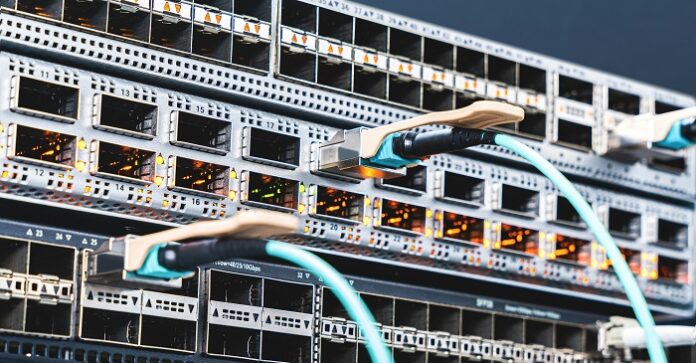The Quad Small Form-factor Pluggable 56 (QSFP56) transceiver represents a significant leap in data center and high-performance computing connectivity, offering speeds of up to 200 Gbps. This advanced optical module is designed to meet the escalating demands for bandwidth in modern networks, providing a scalable and efficient solution for managing data throughput in enterprise environments, cloud computing, and large-scale data centers. The QSFP56 standard not only supports higher data rates but also ensures backward compatibility with existing QSFP form factors, facilitating seamless integration into existing infrastructures. With its compact form factor and power efficiency, the QSFP56 transceiver is pivotal in enabling the next generation of high-speed data transmission technologies.
What is QSFP56 and How Does it Compare to Other Transceivers?
Understanding the QSFP56 Form Factor
The QSFP56 form factor is an evolution in the series of Quad Small Form-factor Pluggable (QSFP) transceivers, designed to cater to the increasing demand for bandwidth in data centers and high-performance computing environments. Its distinguishing feature is the capability to support data rates of up to 200 Gbps, which is a significant advancement from its predecessors. This enhancement is achieved while maintaining the standard QSFP footprint, enabling easy integration into existing network infrastructures without the need for hardware modifications.
Exploring the Differences Between QSFP56 and QSFP-DD
When comparing QSFP56 with the Double Density QSFP (QSFP-DD), the primary difference lies in the max data rate and the density of the connectors. QSFP-DD transceivers can support up to 400 Gbps – doubling the capability of QSFP56 – by utilizing an additional row of contacts to enable an eight-lane electrical interface. This makes QSFP-DD well-suited for ultra-high bandwidth requirements but requires considerations for power and heat management in dense configurations.
Comparing QSFP56 with QSFP28
In contrast to QSFP56, the QSFP28 transceiver supports data rates of up to 100 Gbps, making the QSFP56 an appealing upgrade for networks looking to double their data throughput without significant infrastructural changes. QSFP28 is optimized for 100 Gbps using four lanes of 25 Gbps, whereas QSFP56 achieves its higher data rate by employing four lanes of 50 Gbps or through advanced modulation techniques. This evolution reflects the industry’s trajectory towards higher efficiency and the push for greater bandwidth to support burgeoning data demands.
Key Features and Specifications of QSFP56 Transceivers
QSFP56 transceivers, standing as a pivotal advancement in network technology, are designed to meet the increasing demands for bandwidth and data throughput in contemporary data centers and high-performance computing environments. These transceivers bring forth a substantial leap in data transmission capability, offering support for data rates up to 200 Gbps. This is made possible through the utilization of four lanes, each capable of transmitting data at 50 Gbps. Notably, QSFP56 maintains compatibility with the QSFP form factor, ensuring seamless integration into existing hardware setups without necessitating significant infrastructural overhauls.
Furthermore, QSFP56 transceivers are characterized by their low power consumption, a critical feature that addresses the operational cost concerns tied to data center operations. Enhanced error correction mechanisms are another vital attribute, ensuring data integrity across high-speed transmissions. Additionally, QSFP56 modules are engineered to operate over single-mode and multimode fibers, offering flexibility for long-haul, metro, and data center interconnect applications.
Examining the 200G QSFP56 Transceiver Module
The 200G QSFP56 transceiver module represents a significant advancement in network technology, facilitating high-speed connections and increasing bandwidth capabilities in data centers. It achieves 200 Gbps data transmission rates by leveraging four electrical lanes, each running at 50 Gbps. The QSFP56 module’s compatibility with the QSFP form factor allows for easy upgrade paths in existing infrastructures, enabling data centers to enhance their capabilities without extensive modifications.
Analysis of 400G QSFP56-DD Transceivers
The 400G QSFP56-DD (Double Density) transceivers build upon the foundation laid by the QSFP56, pushing the boundaries of data throughput further to accommodate the escalating data transmission requirements. The “Double Density” designation refers to the transceiver’s double row of electrical contacts, supporting an eight-lane electrical interface. This configuration permits the QSFP56-DD to reach a remarkable data rate of up to 400 Gbps. It is particularly well-suited for applications demanding ultra-high bandwidth and speed, such as in large-scale data centers and next-generation network backbones. However, this increase in capability brings along considerations for enhanced power consumption and heat dissipation requirements, necessitating advanced cooling solutions and power management strategies to ensure reliable operation.
Applications and Use Cases of QSFP56 in Data Centers
Benefits of Using QSFP56 Transceivers in Data Centers
The adoption of QSFP56 transceivers in data center environments presents several notable benefits. Primarily, these modules significantly augment bandwidth capacity and data transmission efficiency. By handling data rates of up to 200 Gbps, QSFP56 modules effectively decrease the number of physical connections required within the data center, leading to streamlined network architectures and reduced complexity. Furthermore, their backward compatibility with existing QSFP form factors ensures a cost-effective upgrade path, permitting data centers to leverage current infrastructure investments while progressively scaling bandwidth capabilities. QSFP56 transceivers also embody advancements in power efficiency; despite their high data rate, these modules are designed to operate within the constrained power budgets typical of dense data center environments. This attribute not only lowers operational costs but also aligns with the increasing environmental sustainability goals of modern data centers.
Exploring Optical Transmission with QSFP56 Modules
QSFP56 modules enable data centers to exploit the advantages of optical fiber transmission, presenting an optimal solution for overcoming the limitations of electrical interconnects over long distances. Optical fiber transmission facilitated by QSFP56 transceivers exhibits superior signal integrity and is less susceptible to electromagnetic interference, supporting longer transmission distances and higher data rates compared to traditional copper cabling solutions. This capability is crucial for inter-data center connectivity and for linking servers within extensive data center facilities. Additionally, the use of QSFP56 modules in optical transmission scenarios underscores the importance of technological innovation in enhancing the scalability, reliability, and efficiency of data center networks, paving the way for future advancements in network infrastructure.
Technical Aspects and Standards of QSFP56 Technology
Understanding the Electrical Interface of QSFP56
The QSFP56 transceiver’s electrical interface is engineered to meet the rigorous demands of high-speed data communication, making it inherently compatible with existing network equipment and protocols. It utilizes an 8 x 25 Gbps configuration, where four channels are dedicated to transmitting data and four to receiving, allowing for duplex communication over the 200Gbps interface. This arrangement ensures that data centers can achieve high data throughput while maintaining backward compatibility with older equipment. The electrical interface of QSFP56 transceivers is designed to minimize signal degradation, implementing advanced equalization techniques to maintain signal integrity over the electrical connections within the data center infrastructure.
Analysis of Modulation Techniques in QSFP56 Transceivers
QSFP56 transceivers incorporate sophisticated modulation techniques to enhance data transmission rates over optical fibers. One of the key technologies employed is Pulse Amplitude Modulation 4-level (PAM4), which allows for a doubling of data rate transmission capability over the same bandwidth when compared to Non-Return to Zero (NRZ) modulation, traditionally used in lower-speed applications. By encoding two bits of information per symbol, PAM4 effectively increases the amount of data transmitted without necessitating a proportional increase in bandwidth or the speed of the components, thus offering a cost-efficient path to scaling network infrastructure.
Introduction to PAM4 Modulation in 200G and 400G Networks
The transition to 200G and 400G networks necessitates the adoption of PAM4 modulation due to its superior efficiency in bandwidth utilization. PAM4 modulation, integral to the QSFP56 specification, divides the signal into four distinct levels, each level representing two bits of digital information. This modulation scheme is more bandwidth-efficient compared to traditional binary modulation techniques, enabling the transmission of higher data rates over the same channel. However, PAM4 introduces new challenges, such as increased sensitivity to noise and signal distortion, necessitating more sophisticated signal processing techniques to maintain signal integrity. The implementation of PAM4 modulation in QSFP56 transceivers is a testament to the continuous evolution of data center technologies, striving to meet the insatiable demand for higher bandwidth and speed in modern network environments.
Future Prospects and Innovations in QSFP56 Technology
Exploring the Compatibility of QSFP56 with IEEE802.3bs Standards
The Quadruple Small Form-Factor Pluggable 56 (QSFP56) technology, pivotal to the advancement in data center infrastructures, aligns closely with the IEEE802.3bs standards, marking a significant stride towards ensuring compatibility and standardization in high-speed data transmissions. The IEEE802.3bs standard, which encompasses 200G and 400G Ethernet operations, underpins the integration of PAM4 modulation technique to meet the escalating demands for bandwidth without compromising the efficiency of network systems. QSFP56 transceivers, engineered to accommodate the PAM4 modulation, inherently support the duplex 200G or single-lane 400G Ethernet connections as prescribed by the IEEE standards. This compatibility not only underscores the versatility of QSFP56 in various networking environments but also its potential to drive future innovations in data transmission technologies.
Future Developments in Quad Small Form Factor Pluggable Transceivers
The evolution of QSFP56 transceivers is anticipated to play a pivotal role in shaping the next generation of data center technologies. Research and development efforts are increasingly focused on overcoming the challenges associated with signal integrity and noise sensitivity inherent in PAM4 modulation. Advanced error correction algorithms and enhanced signal processing techniques are among the innovations being explored to mitigate these issues. Furthermore, the push towards reducing power consumption while maintaining high data rates is expected to drive the development of more energy-efficient transceiver designs. The convergence of these technological advancements will not only bolster the performance and reliability of QSFP56 transceivers but also expand their applicability across a broader spectrum of high-speed networking applications, setting a new benchmark for data transmission efficiency and sustainability in the era of exponential data growth.





